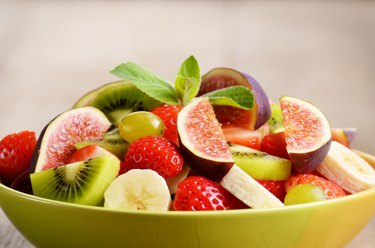
Stent placement is one of the most common treatments for heart disease and artery blockage in the United States. More than 1 million Americans have a stent procedure each year to open blocked cardiac arteries, according to a February 2010 "Wall Street Journal" article. According to stent manufacturer Cordis, eating a healthy diet is an important component to maintaining cardiac health and keeping the artery open after you receive a stent.
Stenting
Video of the Day
Cardiac stenting is a procedure that accompanies angioplasty. A balloon is inserted through the femoral artery into a cardiac artery blocked by plaque. The balloon is inflated to press the artery-blocking plaque against the vessel wall, then deflated. The stent is inserted into the vessel at the same location and then opened. The stent will then remain in the artery, keeping it open and the blood flowing.
Video of the Day
Importance of Diet
Having a stent procedure doesn't mean you're cured of coronary artery disease. "There aren't any cures," says Clyde Yancy, president of the American Heart Association who also serves as a cardiologist at Baylor University Medical Center. In addition to stent placement, making lifestyle changes is an integral part of an overall program to minimize further incidences of coronary artery disease. Yancy and other experts recommend regular exercise, avoiding smoking and eating a heart-healthy diet.
Diet Guidelines
A heart-healthy diet is one that is low in sodium, as well as low in trans and saturated fats and cholesterol. To figure out what exactly these food choices are, the American Heart Association says you should look at the Nutrition Panel on food labels at the grocery store. Eat foods that are free of tans fats, which are also called "partially hydrogenated oils." Also, look on the labels for foods that are low in sodium and cholesterol.
Specific Foods
Nora Saul, a Certified Diabetes Educator and Manager of Nutritional Education at the Joslin Diabetes Center, uses American Heart Association Guidelines in recommending the kinds and amounts of foods you should try to eat on a regular basis after you've undergone stent placement:
At least 4 1/2cups of fruits and vegetables each day. Two 3.5-oz. servings of fish per a week. At least three one 1-oz servings of whole grains. At least four weekly servings of nuts, seeds and beans. No more than two weekly servings of processed meats. A maximum each week of 36 oz. of sugar-sweetened beverages -- such as sodas, sports drinks and juices.
- "Wall Street Journal"; Stents Are Increasingly Common but Not Without Risk; Ron Winslow; February 12, 2010
- Cordis; Component of Maintaining Cardiac Health After Receiving a Stent; April 2003
- Joslin Diabetes Blog; Diet Therapy for Stent Placement; Joslin Communications; April 2011
- American Heart Association; Diet and Lifestyle Recommendations; May 2010
- American Heart Association; Trans Fats; October 2010